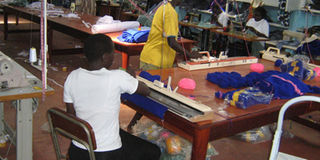Prime
Skills development remains critical as more institutions are registered

Youth need hands-on skills such as knitting that will make them job creators.
With Uganda being the first country in Africa to have free secondary education, the country’s higher education system is set to evolve greatly. Uganda continues to register a growing number of tertiary institutions and universities both private and public.
Statistics from National Council for Higher Education (NCHE), a body that regulates institutions of higher learning indicate, indicate a steady growth. Institutions of higher learning grew to 181 in 2010 up from 148 in 2006, representing a growth of 18 per cent in the four years. These figures include seminaries as well.
Mr Phenny Birungi, the NCHE assistant executive director, says there are five public and 29 private universities, two private and nine public university colleges, 48 private and 51 public tertiary institutions. There is also one public and one private other degree awarding institutions.
It is, however, noted that the growth of higher institutions is in the field of Commerce and Business Studies than the Science and Technical Colleges. But there is a regional imbalance in the number of higher institutions.
Overall, the private sector owns 72 per cent and the public 28 per cent of tertiary institution.Central region dominates with 54 per cent, 20 per cent of the institutions of higher learning are in western while eastern has 15 per cent, and northern Uganda 10 per cent. This partly explains NCHE’s push, in the 2010 report, for the private and public sectors to open up more institutions in eastern and northern Uganda to spur equitable development.
The achievements
Mr Birungi says over time, a couple of achievements have been registered including, the expansion of Uganda’s higher education sub-sector in terms of students’ enrolment and the number of institutions.
There has also been an improvement in female access to higher education, computer access and use, as well as enrolment in science and technology. However the improvement has been mainly reflected in computer related areas rather than basic, mathematical or other technical sciences because many students, parents and policy makers tend to prefer universities to technical education.
Weak point in the sector
Mr Birungi says there is a perception that the quality of Uganda’s higher education is declining. This is indicated in the fact that the percentage of foreign students coming to Uganda has dropped since 2006.
He says such a frightening indicator in the state of higher education and training in Uganda must be noted and addressed immediately. To this, Ms Jessica Alupo, the minister of Education and Sports, says: “The number of foreign students keeps on fluctuating so it does not change a lot and is nothing to worry about. Instead we should aim at improving the general status of institutions of higher education.”
Another challenge is inadequate funding. Education institutions, public and private, receive less funds than it costs them to produce a graduate. This includes funds for carrying out research, which is the core of what a university is yet, “universities are famous due to their research outputs not how well they teach, though this is an important aspect of university service.”
There is also a shortage of academic staff that they say could see Uganda’s higher education sub-sector come to a halt. According to the report, “The few academic staff that we have are not only seeking better opportunities elsewhere, including overseas, but also moonlighting.”
Findings of the report also state that the percentage of students from poor families who study in university institutions is not high.
“Students who study in Uganda’s universities come from relatively better off social economic background than the general Ugandan population. To increase access to higher education for children from poor homes, NCHE recommends that a loan scheme is introduced,” says Mr Birungi.
Ms Alupo says the ministry plans to increase the number of students enrolling in tertiary institutions through the Skills Development Programme designed to help more students get technical skills.
“This will be achieved through the capitation grants given to vocational institutions. We also plan on increasing the number of institutions in the country. And the quota system and government sponsorship are still being given to the best performing A -Level students in the country.”
“In addition, we plan on introducing a loan scheme for students pursuing higher education but that is something we hope to roll out in the next financial year,” she says. All these efforts are in a bid to see more students attain higher education.



